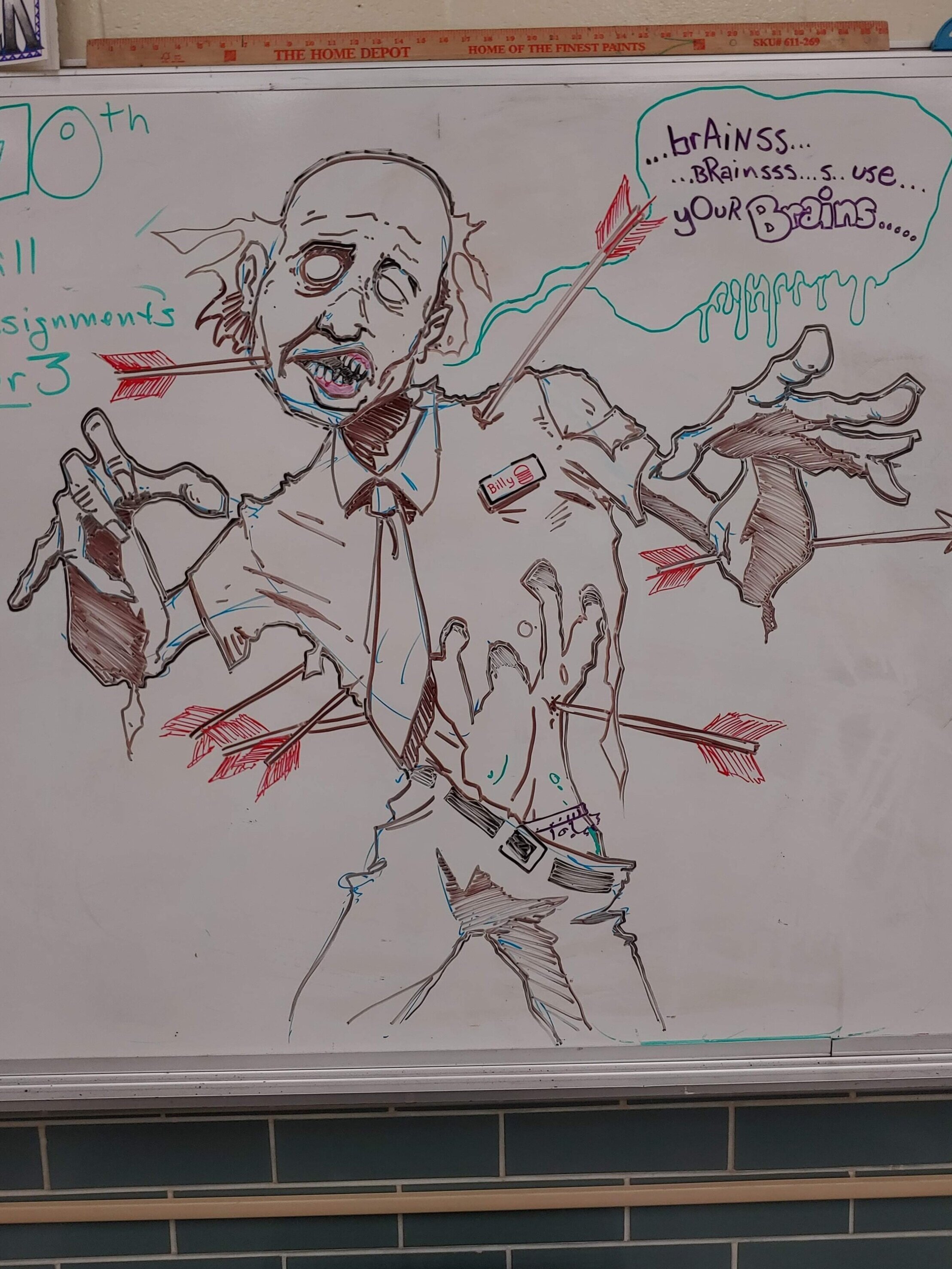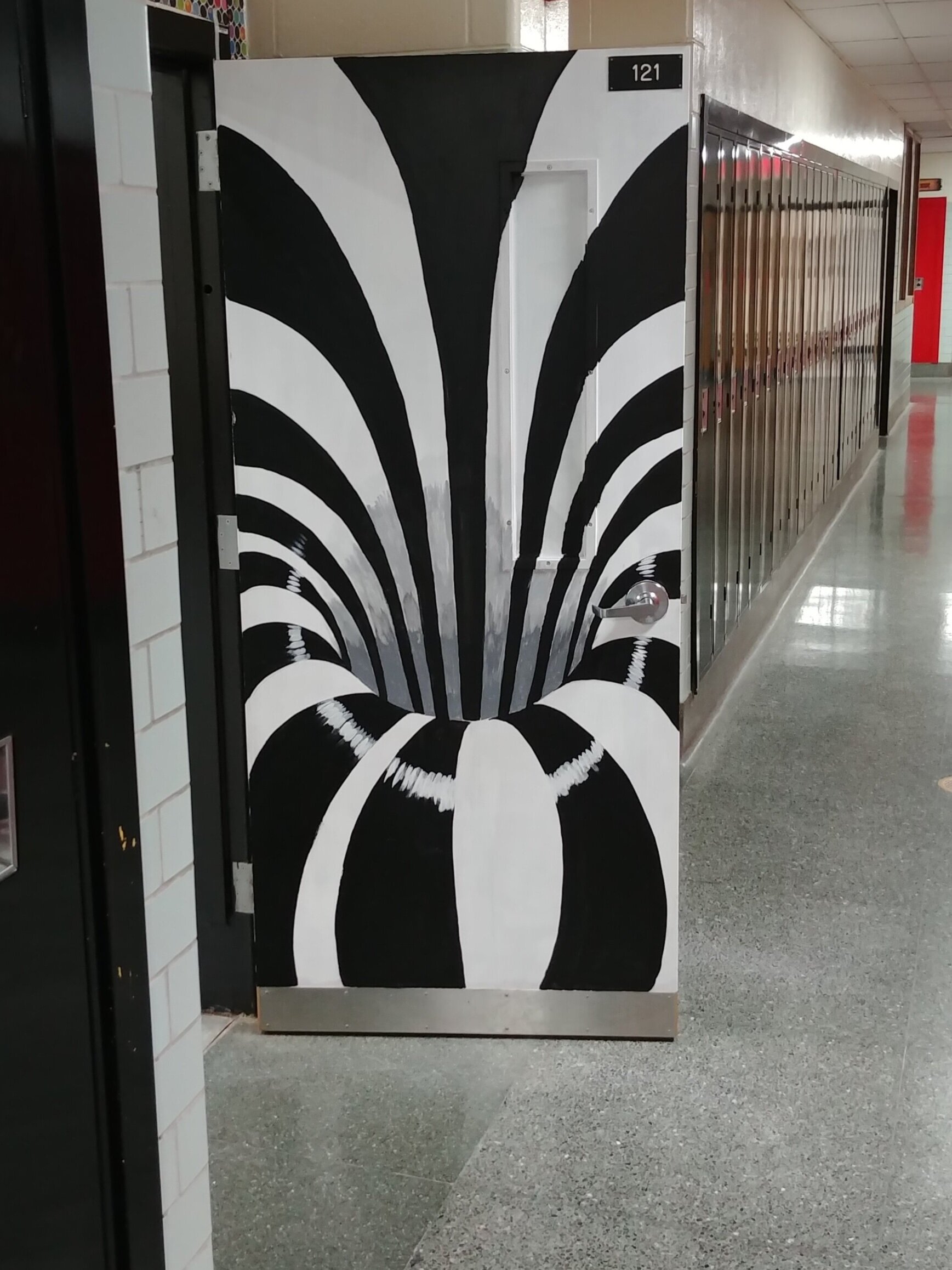I teach digital arts at West Carrollton High School just south of the city of Dayton, Ohio. I was immediately informed of the community and the blue-collar ethos of the area on my first day of orientation into the school district. It is a small community with a population firmly grounded in the shadow of rusting factories in the area. Every generation since WWII in this community had counted on a good paying job and attainable upper middle-class lifestyle until the GM plant was ultimately shuttered in 2008. With hourly wages averaging at less than a third of what they were twenty or even thirty years ago, the community is vastly different.
I try to draw a new illustration on the board weekly.
This defines a vast majority of the students that I teach. Deemed unnecessary by most, education beyond high school was below 16%. When the factories went south, very few people had a working model on what to do next. The lack of importance placed on education is a palpable frustration in the education system. Partnered with a rising poverty rate, it is a demanding situation for the racially diverse population. My own background is similar having come from a school that was both isolated and populated by working class families. I feel a kinship and an obligation to open the eyes of students to some of the possibilities in the arts.
The teachers and administrators fully embrace the heritage and acknowledge our challenges in the school district. I am blessed to be surrounded with committed, passionate teachers. They openly take up the role of the underdog. The art department has two great educators that both have over 10 years teaching experience and live in the community. Their insight has been invaluable. The relationship of the arts in the community and school has primarily been a yearly district art show in conjunction with the Spring play/musical.
Portal into the art space…
This being my first year of teaching art, I was excited to take on my new classroom. Before I saw it, I knew what I wanted and how to define it. The art room should look like the art room. The art is expressive and colorful. My favorite classroom of all time was my 3-Dimensional Illustration class at CCAD taught by Mark Hazelrig. There were giant monster heads, aliens and creature sculptures growing from out of every shelf in the chaotic, yet organized studio. When you walked in, it felt creative. Students walking by would slow down and gawk at the door to see what we were creating in there. It was an art studio and it looked like it. I wanted a space that made students excited about what we were doing in there.
So far, I have brought some of my own art into the room. I have a vast collection of art that my wife does not approve of for hanging in our own living space to share along with the student work from my classes. My digital art studio is connected to the visual art studio and I have an excellent relationship with my neighbor, the visual arts teacher (and art chair for our district). He has a good head start on creating an art space, so I felt I needed to do some catching up. I have begun a floor to ceiling mural and painted both entry doors with “portals” to attract the attention of students. This upcoming year, I plan to continue my mural and expand a new one right out of my front doors and down the hallway.
Physically, my classroom consists of 24 Mac workstations that should conceivably last us another (hopefully) 3 years. One of my biggest achievements was securing funding to place a Wacom tablet at every workstation this year. I was surprised that there was not any form of pen/stylus input for digital art and I was excited to bring that functionality into the classroom. Additionally, I was able to convince the school administrators to expand the digital arts program into a second and third tier class to allow for more advanced digital work. I want to get a program rolling for scholarship applications and monies for students interested in pursuing higher education in the arts.
Portal out of the art space…
One of my notable struggles has been the digital photography class that I have inherited. Taught by two previous teachers, with similar results, it is apparently more than a little challenging to get teenagers to take pictures of something else besides themselves. We also have a social media class, and video news and yearbook courses with far more up to date equipment that seem to suffer the same fate...kids are just reluctant to take photos. I have been offered the opportunity to set the program aside, but I want to give it one more shot. I had some limited success with interjecting food photography and photojournalism in the lockdown and remote learning phase, so I have some hope. I have tried to focus on what makes a good photograph and composition more of the emphasis more so than equipment training.
I feel very blessed to be in an environment teaching high school aged students in digital arts. This is the age group I wanted and the curriculum I wanted to teach. I was sure that I would have to wait years before I would have an opportunity like this and I want to make the most of it.



